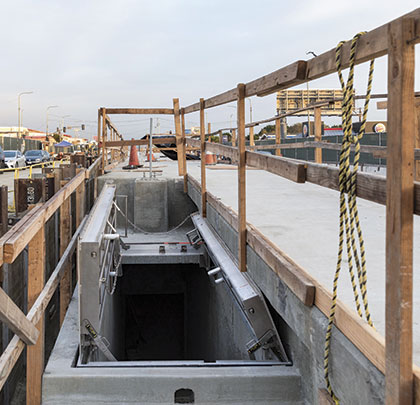Underground construction is especially dangerous, particularly in large urban areas with pipes, wires, and infrastructure that keep a city connected. When Walsh/Shea Corridor Constructors started to build a long rail line in Los Angeles that included underground stations, one of its first objectives was to plan for emergency egress for underground workers.
THE PROJECT
The 8.5-mile Crenshaw/LAX Transit Project rail line includes six emergency exit hatches and four large doors to access underground control systems. The hatches and doors, manufactured by The BILCO Company in New Haven, Connecticut, provide code-compliant egress for underground workers, and eventually, subway riders.
“Even before there were any designs, the engineering team knew that they needed doors that would provide safe and reliable emergency egress,’’ says Dave Pebley of Specialty Building Components, the sales representative for The BILCO Company in Pico Rivera, California. “The doors had to meet code requirements, but also stand up to the demands of the job.”
DOORS FOR EVACUATION
Installed at stops along the entire length of the line, the doors are equipped with many custom features that make them ideal for use in this application.
Each of these heavy doors is supplied with an engineered lift assistance system and a two-point panic locking mechanism that allow the doors to open with less than 30 pounds of force, a critical requirement for safe egress in an emergency. Additional features also need to be added at the ground level where the doors will be installed in sidewalks to ensure reliability and added safety.
To prevent structural damage, the doors are reinforced for vehicular loading to withstand the weight of an occasional car or truck that may drive onto the sidewalk. They also feature a slip resistant coating on the walking surface to ensure safety in these high pedestrian traffic areas.
There are two emergency doors at the Expo/Crenshaw, Martin Luther King, and Leimert Park underground stations. The stations at Hyde Park, Fairview Heights, Downtown Inglewood, and Westchester/Veterans are at-grade and the Aviation/Century stop is elevated, so emergency evacuation doors are not required.
“These doors are located on the sidewalk and had to be tested by the fire department,” Pebley says. “They meet H-20 wheel loading specifications, but are also light enough to be opened easily by one person, which is an engineering challenge.”
BY THE NUMBERS
Construction is the most dangerous job in the United States according to statistics compiled by the Occupational Safety and Health Administration. The federal agency reported 4,836 workers were killed on the job in 2015, an average of more than 93 per week or 13 deaths every day. Underground construction is especially dangerous. In 1997, a worker was killed in the construction of a different Los Angeles project when he was pinned against a subway tunnel. In a 1994 fatality in Los Angeles, a man suffered burns over 90 percent of his body when an acetylene tank exploded while working in a subway tunnel. Work on the Crenshaw Line was even suspended for 4 days after transportation officials saw a series of safety violations.
“Workers know that with those doors in place, they will be able to get out quickly in the event of an emergency,’’ Pebley says. “The other important consideration is back injuries. They’re not going to produce excess strain on an underground or utility worker.”
Subway riders also face danger every time they step into an underground station. In 2005, a coordinated series of terrorist attacks killed 52 people and injured more than 700. Since the London tragedy, there have been more than 15 attacks worldwide, including a blast in 2016 in Belgium that killed 20 people. Potential attacks on U.S. soil in New York (2009) and Washington (2010) were foiled.
AGING INFRASTRUCTURE
Decaying infrastructure and inadequate maintenance also cause concern for riders. In 2015, riders of a Washington, D.C.’s Metrorail system subway stopped because of smoke in a tunnel. Smoke seeped into the cars, one woman died, and 91 people were injured. The cause of the smoke, according to the National Transit Safety Board, was a fire triggered by electrical arcing from a high-voltage rail. The NTSB said the short circuit had gone undetected and unrepaired. In response, the D.C. Metro closed the entire system shortly after the tragedy and found 27 instances of problems related to power cables or connections. In New York, the Metropolitan Transportation Authority reported 525 track fires throughout its subway system in 2015. More than half of them, 329, involved debris, grease, and garbage. The Authority removes nearly 40 tons of garbage each day from the system, which extends across 245 miles.
PLANNED EXPANSION
Planning for this $2.058 billion project started shortly after the Los Angeles riots in 1992 and the extension is designed to better serve transit-dependent residents in the corridor and provide economic stimulus in the region. The project will be the first rail line to serve Crenshaw Boulevard and the city of Inglewood since streetcars of the Los Angeles Rail Line stopped running in 1955. The new light rail line will use the alignment of the streetcars in some instances. It is expected to be operational in 2019.
Los Angeles is amid a major infrastructure update in advance of the 2028 Summer Olympics. Besides the new Crenshaw line, Los Angeles is also building a 9-mile extension to a Westside subway line and an automated people mover that will serve people on the Crenshaw Line and help them connect to the broader Metro rail network.
For More Information:
For more information about the LA Rail Project, visit www.metro.net/projects/crenshaw_corridor.
_________________________________________________________________________
Modern Contractor Solutions, March 2018
Did you enjoy this article?
Subscribe to the FREE Digital Edition of Modern Contractor Solutions magazine.




